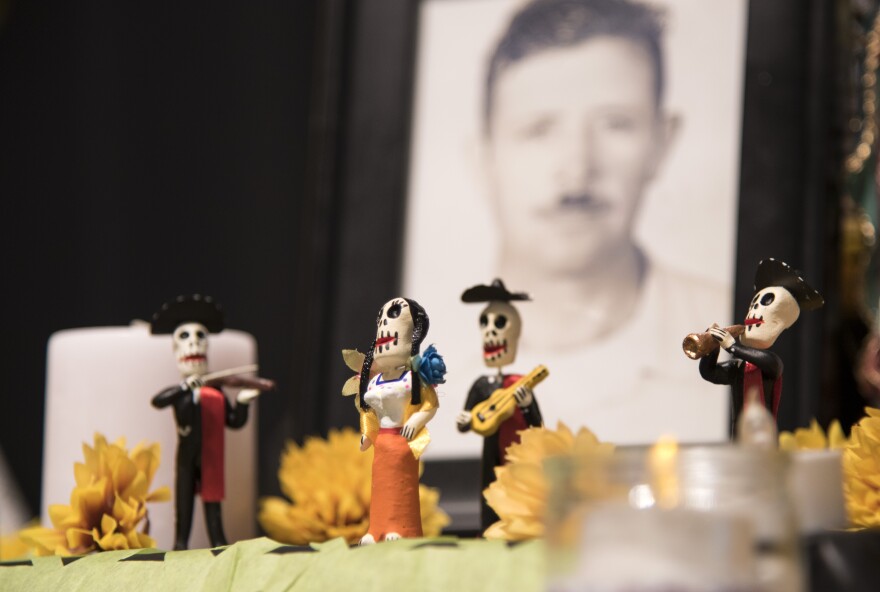The sound of Mexican folk music echoes throughout the lobby of the Sioux City Public Museum. With broad sweeping motions, tiny dancers from Irving Elementary create a colorful flurry of flouncing skirts.
A few of the older girls with La PerlaTapatia have their faces half-painted like La CalaveraCatrina, also known as the “Dapper Skeleton” or “Elegant Skull.” A stark white palette is punctuated by a dark green patch around one eye and skeletal lines extending from the lips.
Proud parents and curious strangers gather around to watch the girls tap and twirl in high-heel boots.

Maria Guzman, one of the teachers with La PerlaTapatia, stands off in the corner in quiet reflection.
“Being at Irving and being a part of the dance group has helped me connect back to my culture, because when I was in Mexico, I used to dance this type of dance, and then when we came here, I never did anymore,” she said. “Now, being able to be a part of it has connected me back to my culture, too.”
Her family moved to the United States when she was 7 years old. They left behind some of their customs and traditions.
This time of year, many Mexican families celebrate Day of the Dead, or Dia de Muertos, which is observed on November 1 and 2.
The holiday’s origins can be traced back to ancient Mesoamerican civilizations. When the Spaniards arrived in the early 1500s, they were appalled by the seemingly pagan practices of the indigenous people and tried to convert them to Catholicism.
Originally celebrated in the summer, the two-month-long festival was moved to coincide with All Saints Day and All Souls Day, but Dia de Muertos refused to die.
Today, it's still celebrated in Mexico and becoming increasingly popular in the United States, including right here in Siouxland.
For the second year in a row, the Sioux City Public Museum hosted a Day of the Dead Celebration. In addition to Sunday’s festivities, families from Irving Elementary built altars, which will be exhibited through Saturday.
The altars honor the dead with symbolic items and offerings that sometimes look eerily similar to decorations for Halloween.

“To us, it’s not a scary holiday,” Guzman said. “It is a happy way of remembering them.”
She has an altar set up for her grandparents who have passed away. Pictures are prominently displayed on the top tiers next to a figurine of the Virgin Mary. Tealights are laid out in the shape of a cross next to a stack of tortillas.
Bright yellow marigolds are scattered among the glass bottles of Coca-Cola and colorful skulls.
Guzman remembers her grandmother’s love of cooking with kitchen utensils and her grandfather’s life on the farm with a little toy horse, rooster and cow.
“It’s a way to honor my grandparents and my parents were actually here,” she said. “They came and saw it and they liked it a lot because they think that I’m keeping my family tradition alive building an altar for my grandparents and to show that I am proud of my culture.”
Day of the Dead altars often include sugar skulls and papelpicado, intricately designed perforated paper banners, representing wind and the fragility of life. There’s also an offering of pan de muerto, or bread of the dead that’s baked with bone-shaped designs on the crust.
Lanett Velazquez, who also helps with La PerlaTapatia, learned a lot about the Mexican holiday through her involvement with the dance group and setting up an altar at the Sioux City Public Museum.
She never lived in Mexico. She’s seen how it doesn’t take long to assimilate to American culture and lose touch with your heritage.
“My parents were from New Mexico, so they kind of lost that culture before my generation,” she said. “Starting this, I’m learning a lot more about my culture than what my parents were able to teach me because they kind of lost that when they moved over here also. It’s nice to kind of connect to that.”

To see the Day of the Dead altars, visit the Sioux City Public Museum between 10 a.m. and 5 p.m. now through Saturday.



